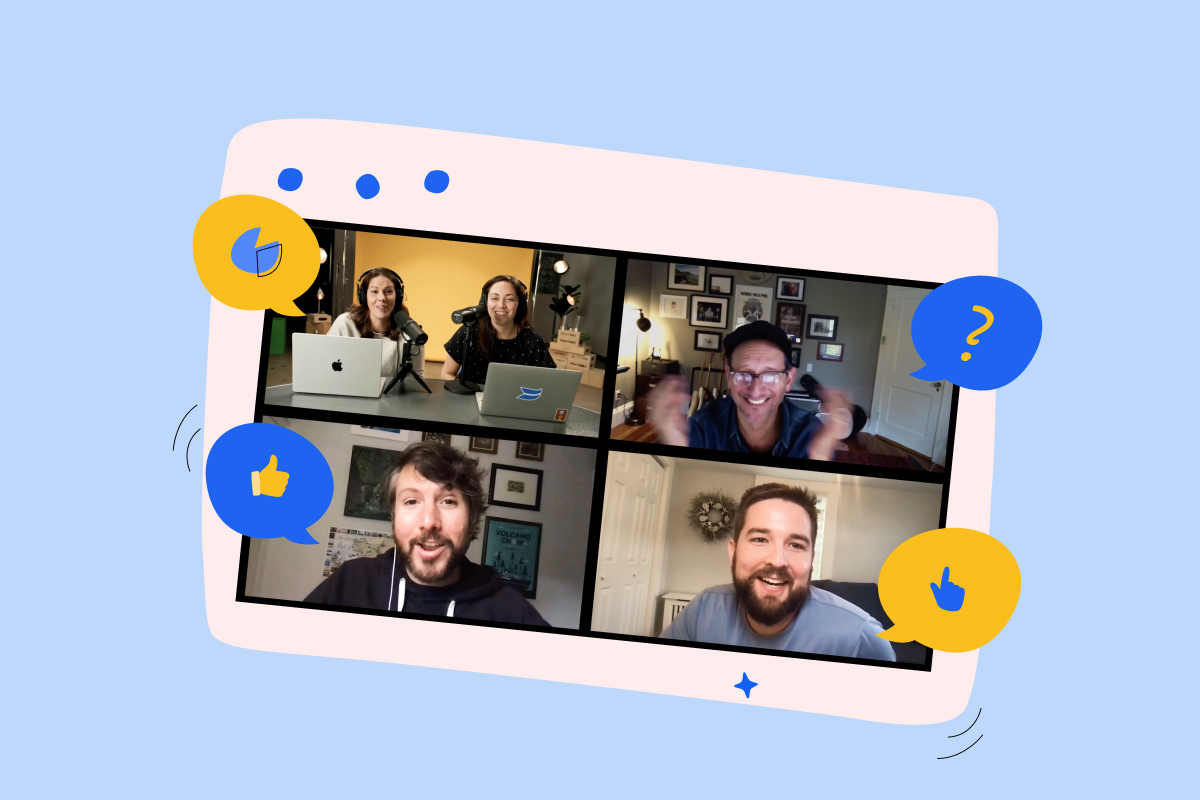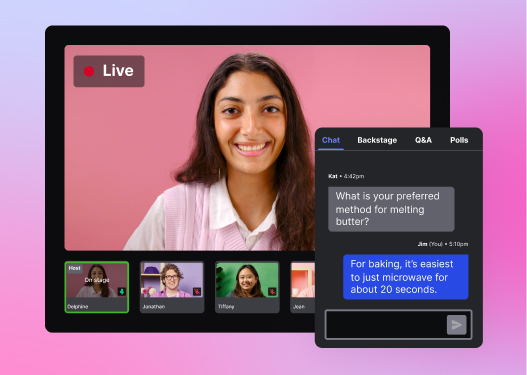What's a Panel Discussion? How to Bring Experts to the Stage
A panel discussion is a great way to bring experts together for a live event.
October 12, 2023
Topic tags

Have you ever listened to a bunch of experts chat about something they’re passionate about? The depth, the insights, and the sheer knowledge being shared make it quite an experience!
You can give your audience that experience by hosting a virtual panel discussion. It’s a fun way to bring together thought leaders in your field, share knowledge, and make your brand stand out.
If you’re interested in hosting a panel discussion online, stick around. We’re going to break down what a virtual panel discussion is and guide you through hosting an impactful one.
What is a panel discussion?
A panel discussion is when a few subject matter experts come together to chat about a specific topic in front of an audience. These experts are often industry leaders or folks with deep knowledge of the subject, and they usually bring a mix of viewpoints to the table.
The main goal of a panel discussion is to share knowledge, provide new insights, and leave the audience with valuable takeaways.
This kind of event usually spans anywhere from 30 minutes to an hour. It’s long enough to dig into the good stuff but short enough to keep everyone engaged. And to keep this chat on track, there’s usually someone in charge: the moderator. They make sure things flow smoothly and that everyone gets their say.
And the best part? The audience isn’t just there to listen. Near the end, they can pitch in with their questions, making the whole event even more dynamic.
What is a virtual panel discussion?
A virtual panel discussion is much like its in-person counterpart except it takes place online via a live event platform. Everyone — from the experts to the audience — logs in from wherever they are. It’s like a global meetup without the travel.
Here are some great reasons to take your panel discussions online:
- Cost savings: No need to spend any money on venues, food, or plane tickets!
- Sustainability: Less travel and fewer physical resources means it’s a win for our planet.
- Safety: No need to worry about the risks associated with big crowds, especially when things like health crises pop up.
- Accessibility: Make your event more inclusive with captions, high-contrast visuals, and compatibility with screen readers.
- Interactivity: With features like live chats and polls, the audience can participate more actively throughout the event.
Why host a panelist discussion?
Setting up a virtual panel discussion might feel like a big job, but it can benefit not just your business but your audience too.
By attending an insightful panel discussion about a topic they’re interested in, your audience will gain a deeper understanding and a well-rounded perspective of the topic. And they might feel more connected to your brand and industry experts.
Hosting a virtual panel discussion can do wonders for your business’s marketing strategy. It’ll help you:
- Attract a broader audience, especially through panelists with a large following
- Become a recognized authority in your field
- Maximize your content strategy by repurposing the recording into various marketing assets
- Build meaningful connections with your audience, fellow experts, and influential industry leaders
- Generate more leads

All-in-one Video Platform
Streamline Your Webinar Process
How to host a virtual discussion panel event
Whether you’re a video marketing pro or you’re just starting out with video, laying out a clear blueprint is key to hosting a successful virtual panel discussion. It’s all about the details in the planning stage. Ready to get it right? Here are seven steps to guide you:
1. Build your dream team
You’ll need a solid team to make sure your event runs smoothly. Here are the key roles you should consider:
- Host: The host is like the event’s friendly face. They welcome everyone, introduce the panelists, and set the vibe. Their main job is to make the audience feel comfortable.
- Moderator: The moderator keeps a close eye on the chat and makes sure everyone’s having a great time. This role also involves keeping track of the time and sharing links or files with the audience.
- Producer: The producer handles the tech stuff. During the live event, they make sure the platform runs smoothly and the sound and visuals are on point.
While the host is usually on camera, the moderator and producer often work their magic behind the scenes.
2. Invite panelists
Put together a team of three to five panelists, with each one offering their own take on the topic.
To find these subject matter experts, start by checking out your own network — you might know a few experts already. You can also hunt for well-known thought leaders who are often mentioned in articles or on social media. You can also spot potential panelists at industry events or webinars.
Once you find the right people, drop them a friendly message explaining what your panel’s about and why you think they’d be a perfect fit.
3. Choose a live streaming platform for your event
When looking for a great webinar platform, consider everything you will need to run a successful event. Pick one that offers easy registration, a simple-to-use interface for everyone, tools like live chat for interaction, high-quality video recording capabilities, and robust analytics.
Wistia’s webinar software is built into the Wistia video marketing platform. With it, you can create a registration page, capture leads, go live, edit your recording, repurpose your recording, and distribute your content all without leaving the platform.
4. Plan out the event structure
Planning your panel discussion isn’t about following a fixed formula. It’s about finding a flow that keeps things lively. Here’s a basic structure to start with, but feel free to tweak it to fit your event and goals. And a tip? Don’t script every moment. Letting the conversation flow naturally is key to keeping your audience engaged.
- Introduction: The host thanks the audience for coming and quickly introduces the topic and panelists.
- Panelists' introductions: Either the host or the panelists themselves share a bit about their background, achievements, and connection to the topic.
- Discussion: The host asks key questions about the topic, and the panelists share their thoughts.
- Audience questions: Now it’s the audience’s turn. They toss questions into the chat or the Q&A function. The moderator picks the best ones for the panelists to answer.
- Closing: The host summarizes the main takeaways, says thanks, and reminds everyone about the recording and what’s next.
5. Prepare your thought leaders for the event
Getting your panelists prepped can really make or break your event. Want to make sure everything goes off without a hitch? Here’s how to get them all set:
Host a pre-event briefing
During this briefing, you’ll go over a few key things to make sure everyone’s in sync:
- The event’s agenda, topics, and flow
- The event’s date, time, and access information
- Ground rules and expectations for decorum and time limits
- Insights about the audience
You can also use this time to let the panelists get to know each other. Familiarity can lead to smoother interactions during the event and spark more natural, engaging conversations for the audience.
Schedule a dry run
Get your panelists, moderator, host, producer, and others together ahead of the event for a tech check and, if there’s time, a dry run. In this session, everyone can get the hang of the platform and sort out any tech glitches.
6. Optimize the audience experience
Before the event, find ways to actively involve the audience in the discussion. Here are some suggestions:
- Enable chat: Encourage your audience to use the chat function for questions and comments during the discussion.
- Plan a Q&A session: Set aside some time for the panelists to answer the audience’s questions.
- Offer live polls: Have your audience answer polls during the discussion to understand their opinions on the topic.
- Share resources: If you or your panelists have helpful links or files backing up their points, grab them beforehand. That way, you can easily share with the audience during the chat.
7. Promote your event
Start inviting folks a few weeks before the event to give them time to slot it into their calendar.
The first thing you want to do is to create a registration page. You can use an event platform like Eventbrite or use a live streaming platform that automatically generates a registration page — like Wistia. Include details like the discussion topic, date, time, virtual location, and panelist lineup.
Once your registration page is ready, it’s time to spread the word far and wide! Share the details about your event (and a link to the registration page) across your distribution channels, including email, social media, and your website. Here are some things you can do to boost the event’s visibility:
- Tag your panelists: Give a shout-out to your panelists by tagging them in your posts, and encourage them to do the same.
- Use promotional materials: Graphics, bite-sized teaser videos, and other eye-catching promo materials can help get the buzz going about your event.
- Engage in paid promotions: Consider investing in targeted ads on platforms like Facebook, Instagram, or LinkedIn to reach a larger and relevant audience.
- Create a unique event hashtag: It can help group all posts related to the event and increase its reach.
Examples of virtual panel discussions
Need some ideas on how to set up your online discussion panel? Well, there are plenty of ways to go about it. Take, for instance, this Ask Me Anything (AMA) discussion we did with our Wistia marketing team in a Webinarpalooza event:
In this panel discussion, our marketing team leaders took questions from the audience and dished out tips, strategies, and insights about Webinarpalooza in a relaxed, unscripted style.
Another way to approach virtual panel discussions is to use slides and video clips as visual aids. We did that in our creative AMA panel discussion. Check it out:
Host your panel discussions with Wistia
With Wistia, you can set up an event in no time, collect leads from your automatically-generated registration page, choose your layout, invite up to four panelists, and go live with confidence. You can host your event recording and edit, repurpose, share, and analyze it without having to download or upload anything.






